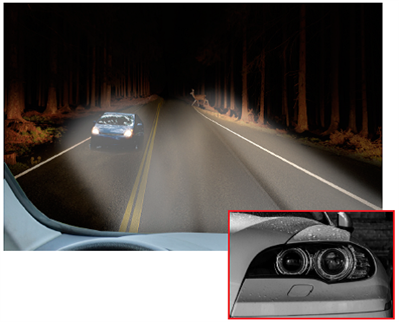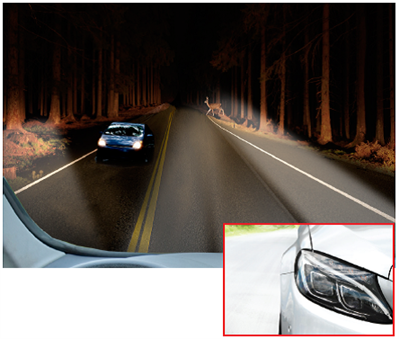SSZTBA3 may 2016 TPS92661-Q1
In my previous blog post, I introduced an automotive light-emitting-diodes (LED) headlight unit using switch-mode regulators. Those LED headlights are static; that is, they either turn on or off. You might turn on the fog lamps when the weather is bad or use your low beams at night and save your high beams when driving uphill. However, have you ever experienced a glare from a vehicle with its high beams turned on (as shown in Figure 1)? Such a glare can be quite dangerous, as it reduces your visibility.
 Figure 1 Traditional Front Light
Technology
Figure 1 Traditional Front Light
TechnologyWouldn’t it be superb if an intelligent system could detect vehicles in oncoming lanes and switch off some portion of that high beam (as shown in Figure 2)? Or if the light changed position according to the position of vehicles in oncoming lanes? In recent years, car manufacturers around the world have been investing in this area; some high-end vehicles are now even equipped with such technology. Let’s explore what’s inside these kinds of headlights.
 Figure 2 Adaptive Front
Lighting
Figure 2 Adaptive Front
LightingAn advanced driver assistance system (ADAS) includes cameras that detect images around the vehicle and provide real-time information to the vehicle’s central control system. The headlights comprise small pixels, which can individually turn on and off or change light intensity. A driver can feed the ADAS information to tell the headlights what to do according to the real-time location of an oncoming vehicle. This is the antiglaring function implemented in an adaptive headlight. An adaptive headlight can also turn beams or a welcome light electronically without motors.
At the end of 2014, TI released the TPS92661-Q1 LED matrix manager to help headlight manufacturers implement adaptive headlights. You can control 12 series LEDs by simply connecting all of them to the TPS92661-Q1. Running on a universal-asynchronous-receiver/transmitter (UART) protocol, an MCU can command the TPS92661-Q1 to control each LED pixel in the matrix. One UART system can connect up to eight TPS92661-Q1 devices (three physical address pins); therefore, the maximum number of pixels for an adaptive headlight is 96 pixels.
The device has 12 individual switches parallel to the LED, connected so the LED can turn on or off or be pulse-width modulation (PWM)-dimmed. The TPS92661-Q1 provides 10-bit PWM dimming resolution, or 1,024 steps of brightness control for each individual LED. Because all LEDs connect to the device individually, its open condition will be protected by shorting the switch in the device, and there is an internal register records fault upon the detection of an LED open or short.
A vehicle that incorporates adaptive LED headlights, enhances road safety and creates a welcomed, safe light? It’s definitely on my wish list.
Be sure to read other blogs on LED lighting.
Additional Resources
- Discover what’s new with LED lighting illumination.
- Check out the TPS92661-Q1 product folder.
- Watch an introduction to the TPS92661-Q1.